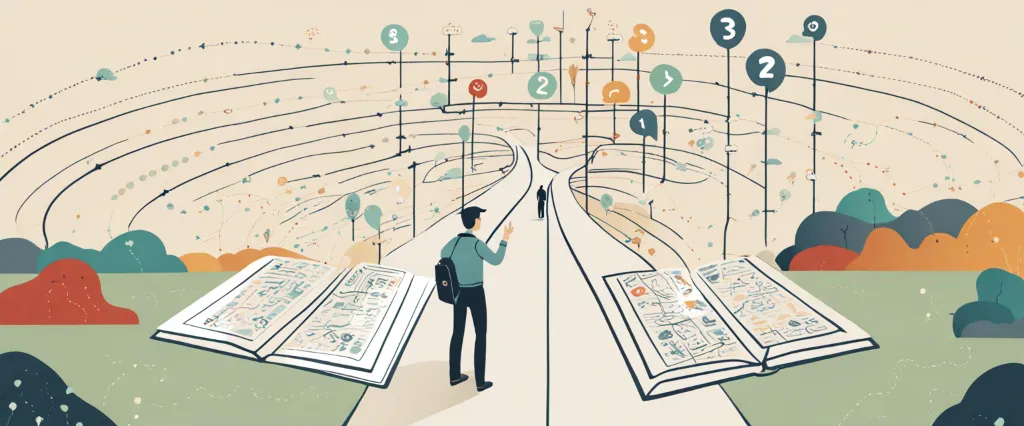——Strengths Finder 20 by Tom Rath & How to Fail at Almost Everything and Still Win Big by Scott Adams

In the realm of self-improvement and personal development, countless books offer promises of success, fulfillment, and happiness. Among these, two prominent works have emerged, each offering a unique perspective on achieving personal excellence and navigating the complexities of life. “Strengths Finder 2.0” by Tom Rath and “How to Fail at Almost Everything and Still Win Big” by Scott Adams are two widely acclaimed books that delve into the principles of self-discovery, growth, and achievement. While both authors aim to assist individuals in their pursuit of success, their approaches and underlying philosophies diverge, presenting readers with distinct paths towards personal fulfillment. Through an examination of their core ideas, techniques, and practical applications, this comparative study seeks to explore the similarities, differences, and potential synergies between these two compelling literary works, ultimately shedding light on the multifaceted nature of personal development and empowering readers in their own journey of self-improvement.
Brief Summary of Two Books
Strengths Finder 20 by Tom Rath
Strengths Finder 2.0 by Tom Rath is a self-help book designed to help individuals identify and develop their unique strengths and talents. Unlike traditional self-improvement methods that focus on fixing weaknesses, this book encourages readers to harness their innate talents and use them to excel in various aspects of life.
The book begins with an introduction that explains the concept of strengths and highlights the importance of understanding and leveraging them for personal and professional success. Rath argues that people who focus on their strengths are more engaged, productive, and happier. He introduces the concept of the StrengthsFinder assessment, an online tool developed by Gallup, which helps individuals identify their top five strengths out of 34 possible themes.
The core of the book revolves around the 34 strengths themes, each accompanied by a detailed description, real-life examples, and action items to maximize that specific strength. The language used is simple and accessible, making it easy for readers to understand their strengths and how to apply them in their daily lives.
Furthermore, Rath emphasizes the importance of utilizing these strengths in various areas, including work, relationships, and personal development. He provides strategies for leveraging strengths within teams and organizations, discussing how to create a balanced team by combining individuals with different strengths.
The book concludes by emphasizing the need for continuous growth and development by regularly revisiting and refining one’s strengths. Rath suggests creating an action plan to integrate strengths into everyday life and offers additional resources and suggestions for further exploration.
Overall, Strengths Finder 2.0 offers practical guidance and valuable insights for individuals seeking to uncover and maximize their strengths, enabling them to lead more fulfilling, successful lives.
How to Fail at Almost Everything and Still Win Big by Scott Adams
“How to Fail at Almost Everything and Still Win Big” is a self-help book written by Scott Adams, the creator of the famous Dilbert comic strip. In this book, Adams shares his personal experiences and offers advice on navigating the unpredictable world of success.
The book emphasizes the idea that failure is not necessarily a bad thing, but rather a natural part of the learning process. Adams argues that through failure, one can gain valuable lessons and insights that can ultimately lead to success. He shares various failures and setbacks he experienced throughout his career and explains how he managed to turn them into opportunities for growth and achievement.
Adams stresses the importance of developing a system instead of relying solely on goals. He encourages readers to focus on continuous improvement and learning from mistakes, rather than fixating on specific outcomes. He also emphasizes the significance of habits, as they can help establish a solid foundation for success.
Moreover, Adams addresses topics such as the importance of health, energy management, and developing valuable skills that are difficult to automate or outsource. He delves into subjects like goal-setting, decision-making, and the power of persuasion, offering practical strategies and insights on how to improve these aspects of one’s life.
Overall, “How to Fail at Almost Everything and Still Win Big” presents a unique perspective on success, highlighting the role of failure as an essential part of the journey. It provides readers with valuable advice and actionable steps to help them embrace failure, learn from it, and ultimately achieve their goals.
Comparison between Two Books

Similarities in Career Development
While there are some differences between “Strengths Finder 2.0” by Tom Rath and “How to Fail at Almost Everything and Still Win Big” by Scott Adams, both books emphasize the importance of self-awareness and personal development in career growth. Here are a few similarities in their approach to career development:
1. Focus on Strengths: Both authors advocate for leveraging one’s strengths rather than trying to fix weaknesses. Rath suggests that identifying and maximizing our natural talents and abilities can lead to greater success and job satisfaction, while Adams stresses the importance of finding and cultivating a unique combination of skills that can be applied in various career paths.
2. Continuous Learning: Rath and Adams emphasize the importance of continuous learning and acquiring new skills to stay relevant in today’s rapidly changing job market. They both encourage readers to cultivate a growth mindset and seek opportunities for personal and professional growth.
3. Goal Setting and Planning: Both authors emphasize the significance of setting clear goals and creating a plan to achieve them. Rath emphasizes the need to align goals with personal values and strengths, while Adams suggests using systems instead of goals to navigate through life’s uncertainties and increase the chances of long-term success.
4. Adaptability and Creativity: Rath and Adams recognize the importance of adaptability and creativity in today’s career landscape. They both highlight the necessity of embracing change, being open to new possibilities, and thinking outside the box. Both authors argue that taking an entrepreneurial mindset, even within an organization, can lead to innovative thinking and increased career opportunities.
5. Networking and Building Relationships: Rath and Adams underscore the importance of building and nurturing relationships. Rath emphasizes the value of developing a strong support network and surrounding oneself with positive influences, while Adams suggests leveraging one’s social skills and cultivating a diverse network to create career opportunities.
It’s important to note that while these books share similarities, they also offer unique perspectives on career development. Understanding and integrating the concepts from both books can provide a well-rounded approach to personal and professional growth.
Divergences in Career Development
Strengths Finder 2.0 by Tom Rath and How to Fail at Almost Everything and Still Win Big by Scott Adams are both popular self-help books that offer unique perspectives on personal growth and success. While both books touch on various aspects of career development, they approach the subject from different angles, resulting in divergent advice and strategies.
Strengths Finder 2.0 primarily emphasizes identifying and nurturing one’s innate strengths and talents. Rath proposes that focusing on one’s strengths and leveraging them effectively is the key to achieving success and satisfaction in one’s career. The book introduces the concept of strengths-based development, which involves identifying specific strengths through an online assessment and subsequently using them as a foundation for personal and professional growth. According to Rath, individuals should aim to cultivate their strengths rather than fixate on improving weaknesses.
On the other hand, How to Fail at Almost Everything and Still Win Big has a more unconventional approach to career development. Written by cartoonist Scott Adams, the book stresses the value of developing a wide range of skills and experiences rather than solely relying on strengths. Adams encourages readers to explore different areas, pursue a diverse set of interests, and develop a “talent stack” – a combination of skills that can make individuals indispensable in the workplace. He believes that rather than pursuing a predetermined career path, one should focus on developing a broad range of skills that can be valuable in diverse situations.
In terms of divergence on career development, the key difference between the two books lies in their contrasting approaches. Strengths Finder 2.0 focuses on identifying and enhancing existing strengths, advocating a specialized and targeted approach to career development. Rath argues that by honing one’s strengths, individuals can find fulfillment, achieve exceptional performance, and stand out in their chosen field.
Conversely, How to Fail at Almost Everything and Still Win Big suggests a more adaptive and flexible approach to career development. Adams encourages readers to embrace failure, experiment, and adopt a systemic mindset. He emphasizes the acquisition of various skills to create a unique combination that can differentiate individuals in the job market. According to Adams, this broad skillset allows individuals to be versatile and adaptable, increasing their chances of success in multiple domains.
In summary, while Strengths Finder 2.0 advocates a strengths-based approach to career development, focusing on identifying and cultivating existing talents, How to Fail at Almost Everything and Still Win Big promotes a more diversified approach emphasizing the development of multiple skills. These differences highlight the divergence of their approaches to career development, providing readers with alternative strategies to pursue professional growth.

Conclusion
Both “Strengths Finder 2.0” by Tom Rath and “How to Fail at Almost Everything and Still Win Big” by Scott Adams offer valuable insights, but it ultimately depends on your personal interests and goals.
If you are looking for a book that helps you understand and utilize your strengths to achieve success, “Strengths Finder 2.0” is a solid choice. The book introduces the concept of focusing on your strengths rather than trying to fix weaknesses, guiding you towards a more fulfilling and productive life by improving upon your natural talents.
On the other hand, “How to Fail at Almost Everything and Still Win Big” takes a different approach. Written by the creator of the Dilbert comic strip, the book shares Scott Adams’ personal experience and unconventional strategies for achieving success. It explores themes like embracing failure, developing a systems mindset, and creating opportunities through passions and skill development.
If you prefer a more practical and actionable guide, “Strengths Finder 2.0” may be the better option as it provides a structured approach to understanding and leveraging your strengths. However, if you prefer a more narrative style with humorous anecdotes and unique perspectives, “How to Fail at Almost Everything and Still Win Big” may be more enjoyable.
Ultimately, both books have their own merits and can offer valuable insights. It depends on what you are looking to gain from your reading experience and which approach resonates more with you.


